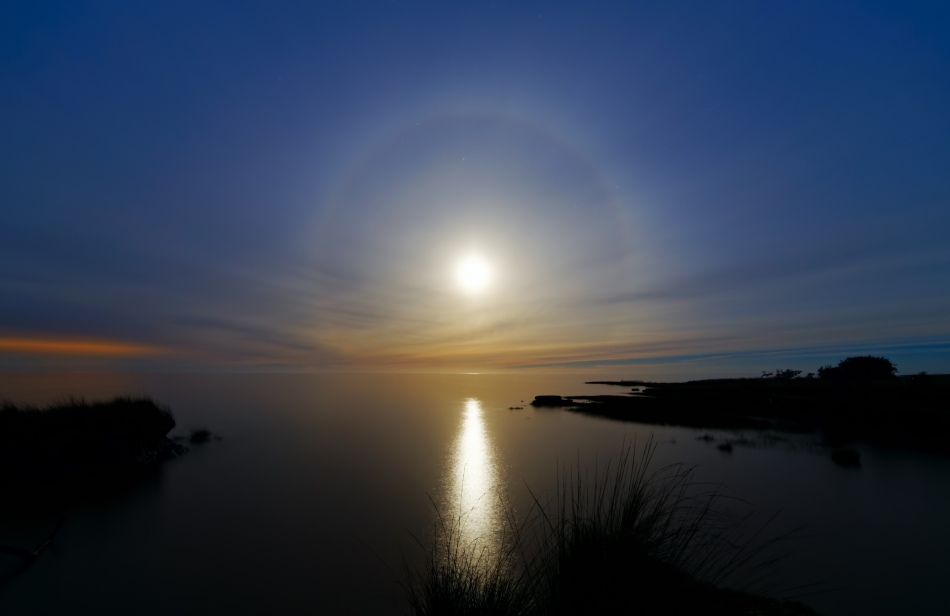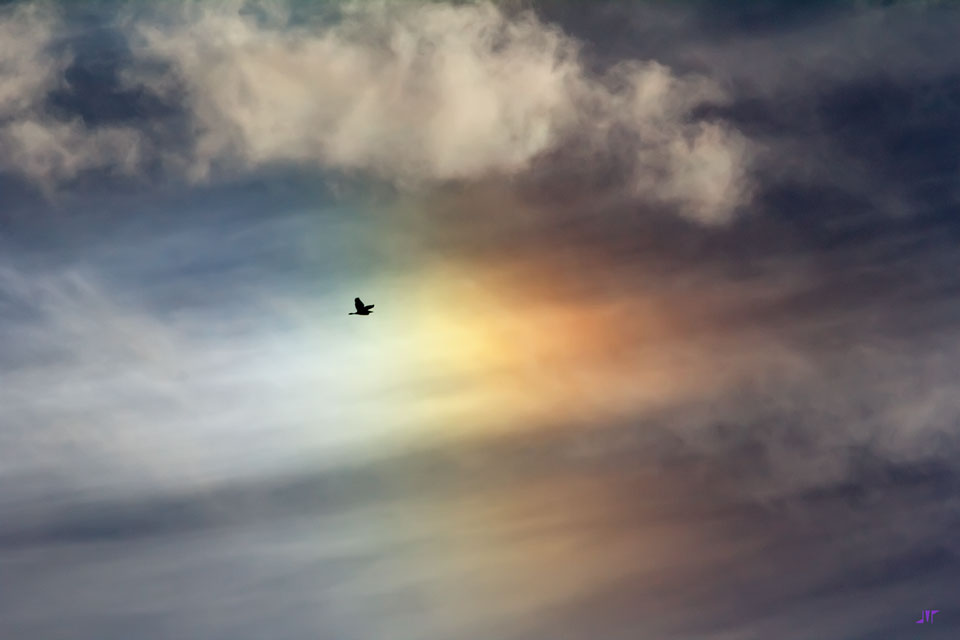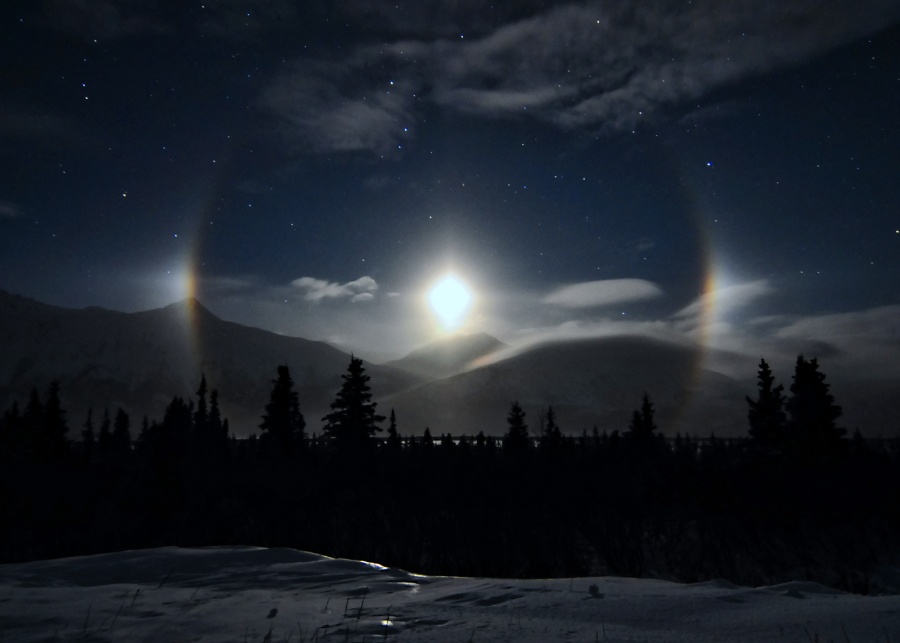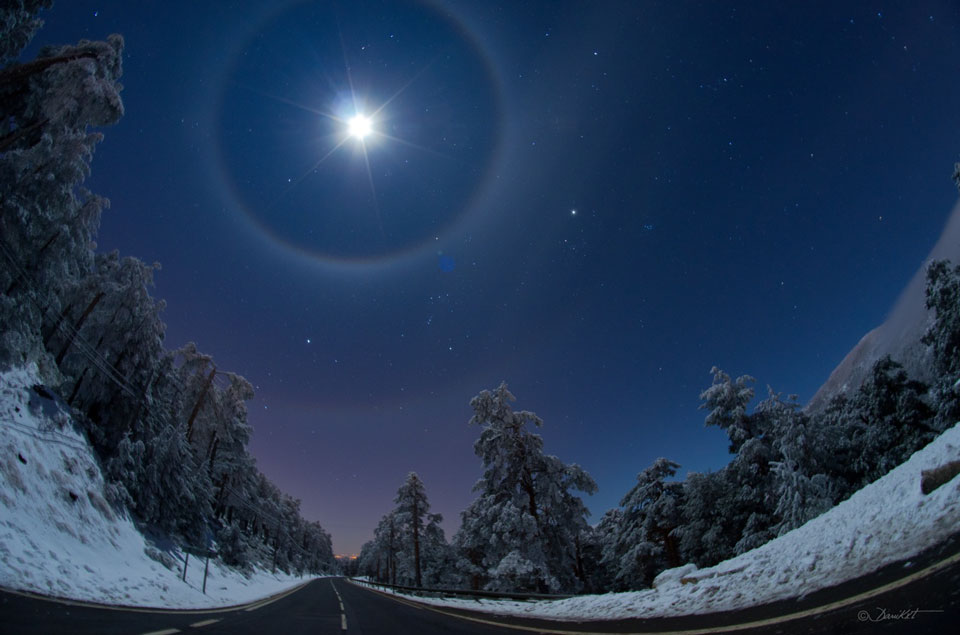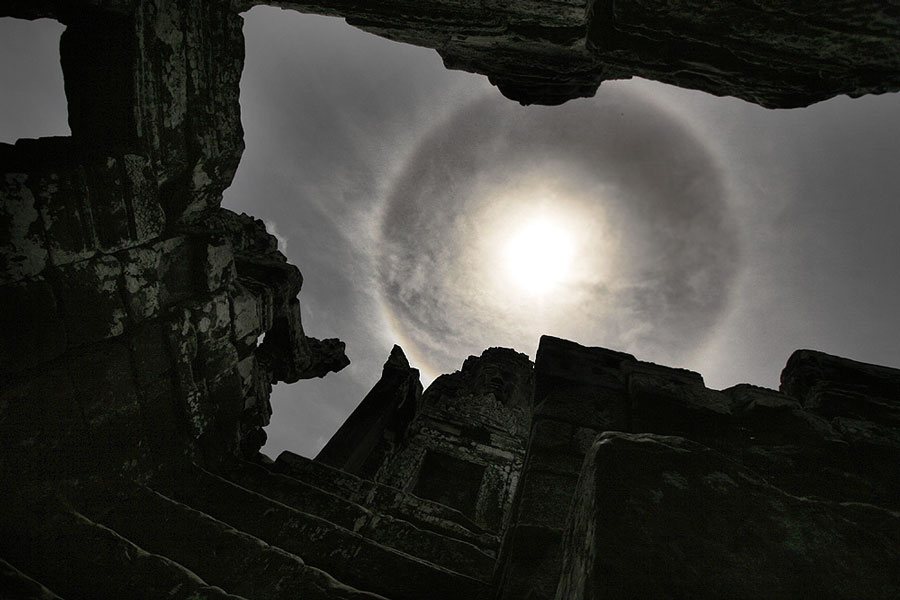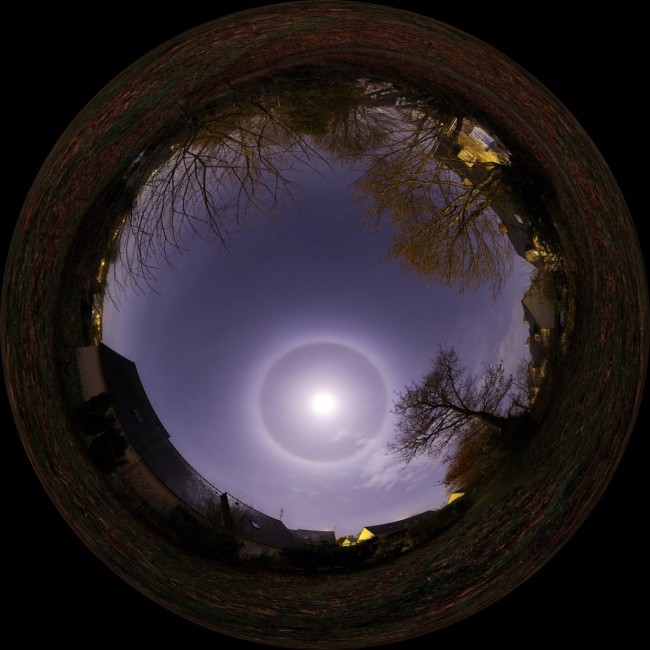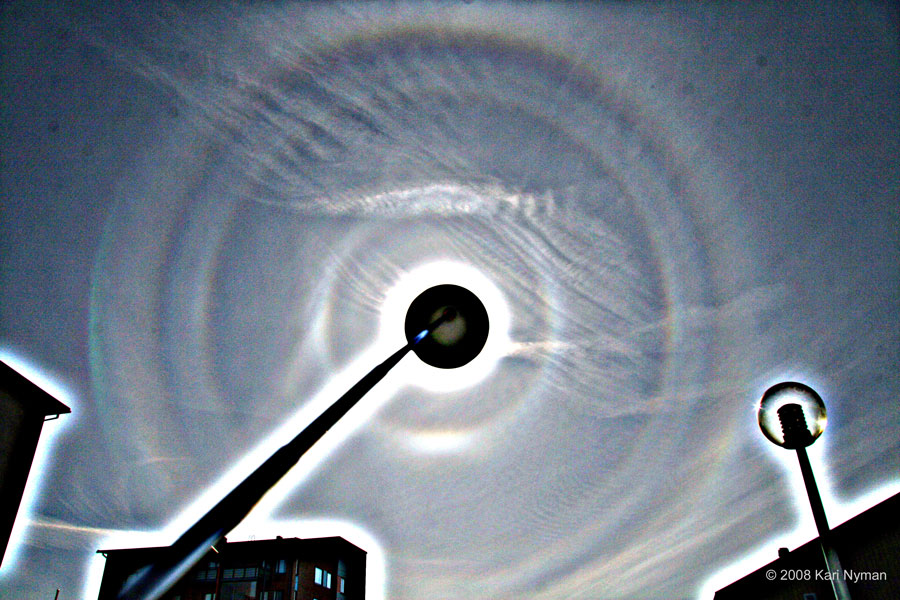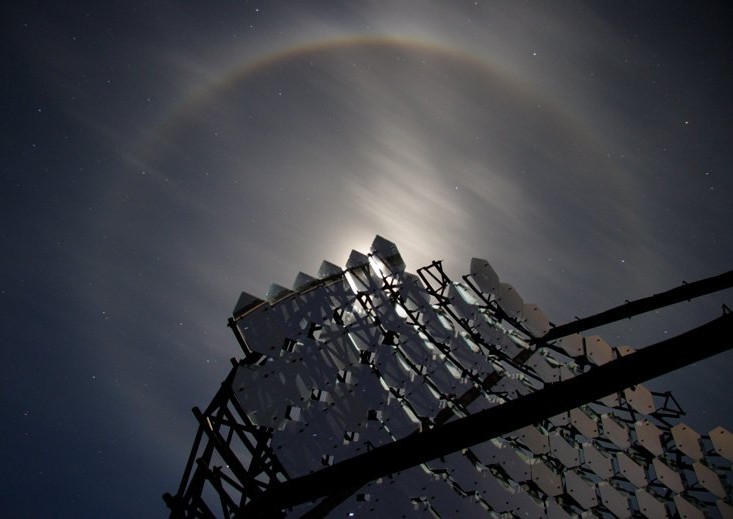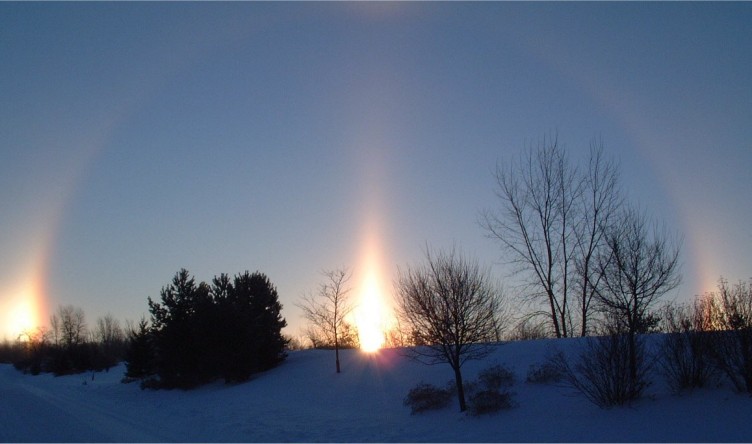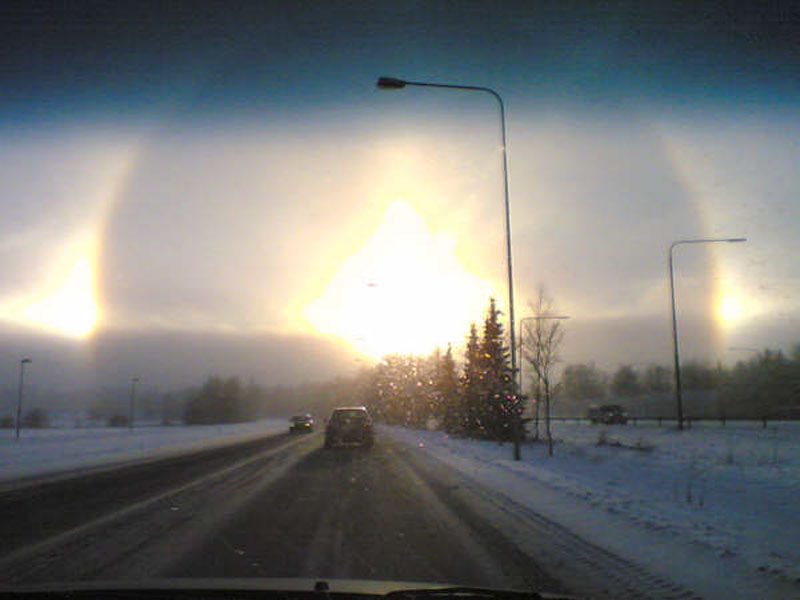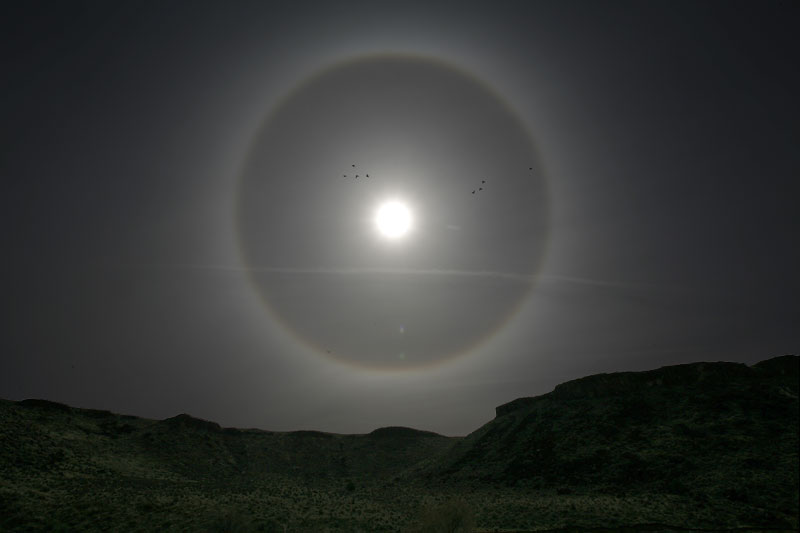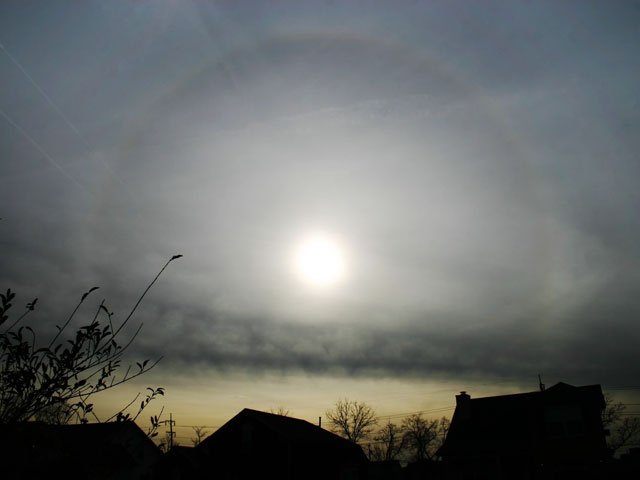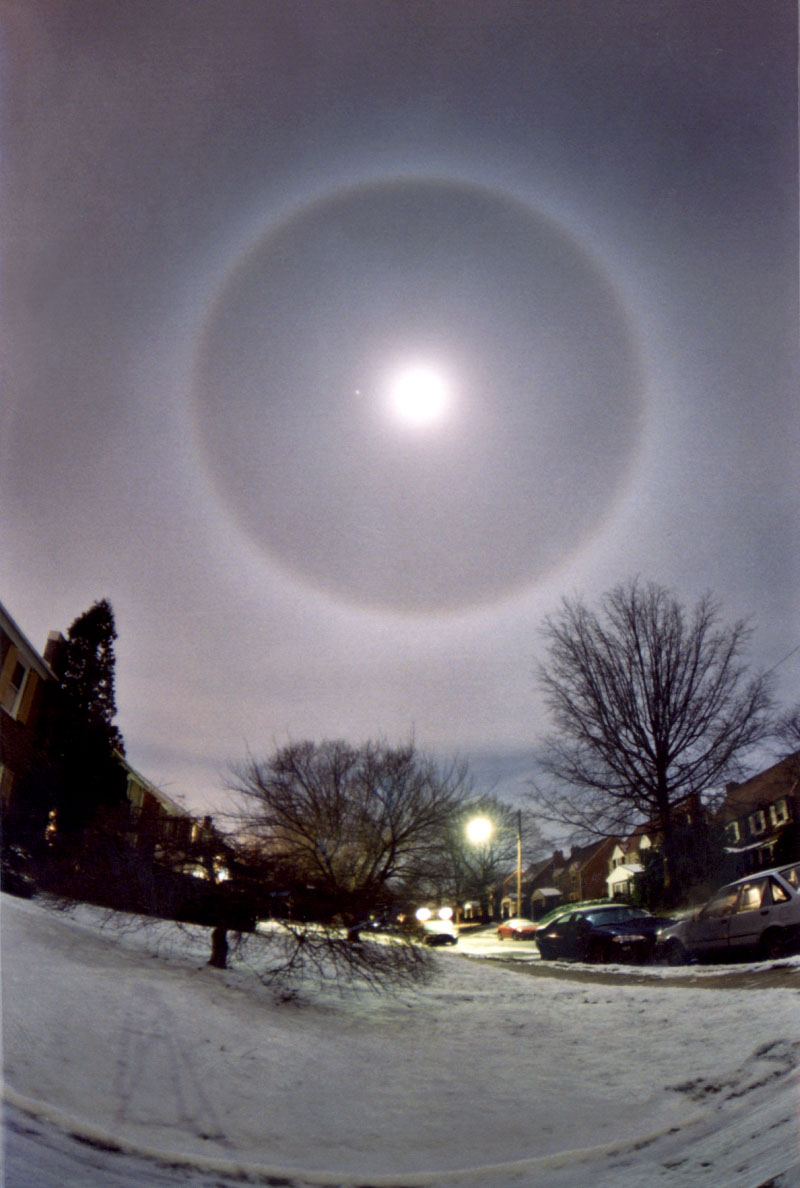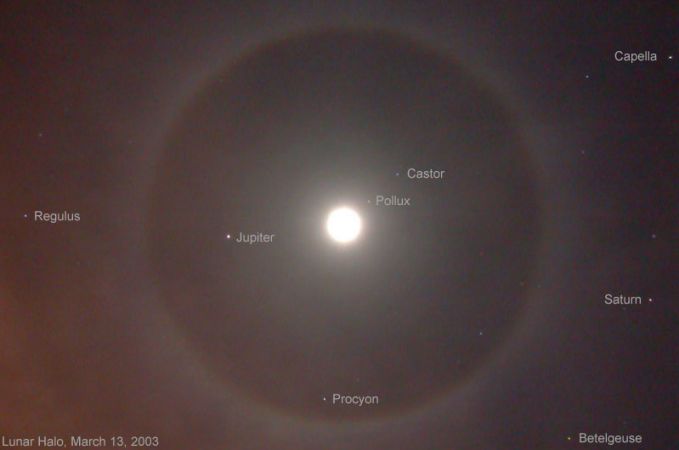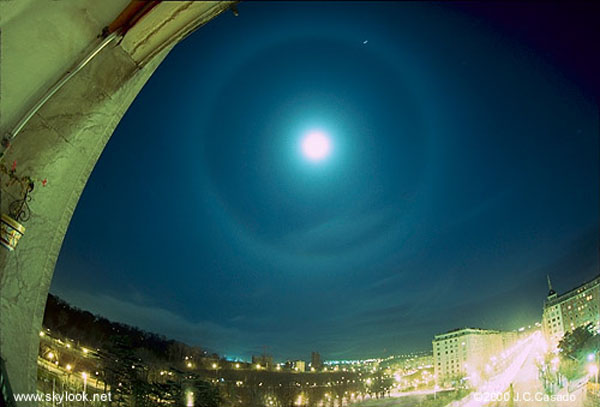APOD Collection: Halos
APOD Collection: Halos
2013 June 28 A Full Perigee Moon rose as the Sun set last Sunday. At its closest to Earth it was, by just a bit, the year's brightest and largest Full Moon also known as a Super Moon. Seen from Punta Piedras, Argentina and the mouth of the Rio de La Plata, near Buenos Aires, the Super Moon's light created this magnificent circular lunar halo. Still, the size of a lunar halo is determined by the geometry of six sided water ice crystals in planet Earth's high, thin clouds. The crystals deflect the rays of moonlight more strongly through a minimum angle of 22 degrees. So this halo has an inner radius of 22 degrees, just like the halos of the less-than-super moons. Even more common than a Super Moon, beautiful 22 degree halos can be spotted at any time of year.
2013 May 27 Have you ever seen a little rainbow off to the side of the Sun? Rare but rewarding to see, such spectacles are known as sundogs, mock suns or parhelia. Sundogs are just sunlight refracting through hexagonal falling ice crystals in the Earth's atmosphere. When thin ice crystals flitter down nearly horizontally, they best refract sunlight sideways and create sundogs. Alternatively, randomly oriented ice crystals may create a complete circular sun halo. Sundogs occur 22 degrees to each side of a setting or rising Sun, although sometimes nearby clouds can block one or both. The above image was taken through a polarizing filter during October 2012 in Mérida, Spain.
2013 January 26 Moonlight illuminates a snowy scene in this night land and skyscape made on January 17 from Lower Miller Creek, Alaska, USA. Overexposed near the mountainous western horizon is the first quarter Moon itself, surrounded by an icy halo and flanked left and right by moondogs. Sometimes called mock moons, a more scientific name for the luminous apparitions is paraselenae (plural). Analogous to a sundog or parhelion, a paraselene is produced by moonlight refracted through thin, hexagonal, plate-shaped ice crystals in high cirrus clouds. As determined by the crystal geometry, paraselenae are seen at an angle of 22 degrees or more from the Moon. Compared to the bright lunar disk, paraselenae are faint and easier to spot when the Moon is low.
2012 December 3 Sometimes falling ice crystals make the atmosphere into a giant lens causing arcs and halos to appear around the Sun or Moon. This past Saturday night was just such a time near Madrid, Spain, where a winter sky displayed not only a bright Moon but as many as four rare lunar halos. The brightest object, near the top of the above image, is the Moon. Light from the Moon refracts through tumbling hexagonal ice crystals into a 22 degree halo seen surrounding the Moon. Elongating the 22 degree arc horizontally is a circumscribed halo caused by column ice crystals. More rare, some moonlight refracts through more distant tumbling ice crystals to form a (third) rainbow-like arc 46 degrees from the Moon and appearing here just above a picturesque winter landscape. Furthermore, part of a whole 46 degree circular halo is also visible, so that an extremely rare -- especially for the Moon -- quadruple halo was actually imaged. The snow-capped trees in the foreground line the road Puerto de Navacerrada in the Sierra de Guadarrama mountain range near Madrid. Far in the background is a famous winter skyscape that includes Sirius, the belt of Orion, and Betelgeuse all visible between the inner and outer arcs. Halos and arcs typically last for minutes to hours, so if you do see one there should be time to invite family, friends or neighbors to share your unusual lensed vista of the sky.
2012 November 20 Have you ever seen a halo around the Moon? This fairly common sight occurs when high thin clouds containing millions of tiny ice crystals cover much of the sky. Each ice crystal acts like a miniature lens. Because most of the crystals have a similar elongated hexagonal shape, light entering one crystal face and exiting through the opposing face refracts 22 degrees, which corresponds to the radius of the Moon Halo. A similar Sun Halo may be visible during the day. The setting of the above picture is Athens, Greece. The distant planet Jupiter appears by chance on the halo's left. Exactly how ice-crystals form in clouds remains under investigation.
2012 February 11 Lighting the night last Tuesday, February's Full Moon is sometimes called the Snow Moon. But the Moon was not quite full in this mosaicked skyscape recorded on February 2 south of Budapest, Hungary, and there was no snow either. Still, thin clouds of ice crystals hung in the cold, wintry sky creating this gorgeous lunar halo. Refraction of moonlight by the six-sided crystals produce the slightly colored halo with its characteristic radius of 22 degrees. Just below the Moon is bright star Aldebaran. Also well within the halo at the right is the Pleiades star cluster. At the lower left, near the halo's edge lie the stars of Orion with bright Capella, alpha star of the constellation Auriga, just beyond the halo near the top of the frame.
2011 January 10 What's happened to the Sun? Sometimes it looks like the Sun is being viewed through a large lens. In the above case, however, there are actually millions of lenses: ice crystals. As water freezes in the upper atmosphere, small, flat, six-sided, ice crystals might be formed. As these crystals flutter to the ground, much time is spent with their faces flat, parallel to the ground. An observer may pass through the same plane as many of the falling ice crystals near sunrise or sunset. During this alignment, each crystal can act like a miniature lens, refracting sunlight into our view and creating phenomena like parhelia, the technical term for sundogs. The above image was taken last year in Stockholm, Sweden. Visible in the image center is the Sun, while two bright sundogs glow prominently from both the left and the right. Also visible is the bright 22 degree halo -- as well as the rarer and much fainter 46 degree halo -- also created by sunlight reflecting off of atmospheric ice crystals.
2010 February 8 Have you ever seen a halo around the Sun? This fairly common sight occurs when high thin clouds containing millions of tiny ice crystals cover much of the sky. Each ice crystal acts like a miniature lens. Because most of the crystals have a similar elongated hexagonal shape, light entering one crystal face and exiting through the opposing face refracts 22 degrees, which corresponds to the radius of the Sun halo. A similar Moon halo may be visible during the night. Pictured above, a nearly complete sun halo was photographed high above the ancient Bayon temple in Angkor, Cambodia. Exactly how ice-crystals form in clouds remains under investigation.
2009 February 13 If your sister-in-law phoned you at 1am to tell you there was a circle around the Moon, how would you react? When it happened to him early last Sunday morning, photographer Laurent Laveder, grabbed his equipment and ran outside! He was rewarded with the sight of a bright lunar halo shining in his neighborhood skies above Quimper, France. With a radius of 22 degrees, the beautiful halo is produced by the refraction of moonlight in hexagonal-shaped ice crystals formed in thin, high clouds. Laveder captured a series of digital images that he used to create this composite fisheye view as well as a remarkable 360 degree VR panorama.
2008 June 18 What if the atmosphere above you became one gigantic lens? This actually happens when a nearly transparent sheet of pyramid shaped ice crystals falls from the sky in a common orientation. These ice-crystals act together like millions of miniature ice mirrors, with external and internal reflections from different faces creating arcs and halos of different radii. An amazing display of pyramid ice crystal halos was captured on June 5 above Tampere, Finland. Visible above are very unusual sun halos of 9, 18, 20, 23, and 24 degrees. In contrast, thin and flat falling ice crystals will produce a halo of 22 degrees only. The high clouds containing the ice crystals are faintly visible, as are some sundogs. The usual Sun image was covered behind a light post, and the above image was significantly digitally sharpened. It is not currently known how large areas of nearly uniform pyramidal ice crystals form.
2008 May 16 Gazing skyward on a sunny day in May, photographer Jean-Marc Lecleire captured this engaging display of ice halos forming complete circles in the sky. Recorded with a fish-eye lens from a spot near the grand Château de Chambord in France, the picture looks straight up, spanning almost 180 degrees from horizon to horizon. Surrounding the Sun is a halo formed by sunlight refracting through hexagonal-shaped ice crystals in high, thin clouds. The halo is circular and exactly 22 degrees in radius, but it looks squashed because of the distortion of the extremely wide-angle lens. Surrounding the zenith (the point directly above the observer) and always at the same altitude as the Sun is a lovely parhelic circle, caused by sunlight reflecting from ice crystals with nearly vertical faces. On average more common than rainbows, beautiful ice halos can often be seen in planet Earth's sky by those who know how to look for them.
2006 November 9 As a bright November Moon lit up the night sky last week, Gil Esquerdo spotted this lovely Moon halo overhead at the Whipple Observatory on Mt. Hopkins, Arizona. In the foreground, the structure and individual component mirrors of Whipple's 10 meter gamma-ray telescope actually block direct light from the lunar disk, emphasizing the halo in this dramatic view. The halo was caused by ice crystals in the thin high clouds above the observatory - crystals that are hexagonal in shape and produce the characteristic ring of light with a 22 degree radius. In fact, the ice crystal shapes are much like the flat, hexagonal mirrors of the specialized telescope in the picture. Used together the mirrors can collect brief flashes of optical light caused by high-energy gamma-rays impacting Earth's atmosphere.
2006 September 23 Today, the Sun rises due east at the Equinox, a geocentric astronomical event that occurs twice a year. To celebrate, consider this view of the rising Sun and a lovely set of ice halos recorded on a cold winter morning near Green Bay, Wisconsin, USA, planet Earth. Produced by sunlight shining through common atmospheric ice crystals with hexagonal cross-sections, such halos can actually be seen more often than rainbows. The remarkable sunrise picture captures a beautiful assortment of the types most frequently seen, including a sun pillar (center) just above the rising Sun surrounded by a 22 degree halo arc. Completing a triple sunrise illusion, sundogs appear at the far left and far right edges of the 22 degree arc. An upper tangent arc is also just visible at the very top of the view.
2006 June 13 What's happened to the Sun? Sometimes it looks like the Sun is being viewed through a large lens. In the above case, however, there are actually millions of lenses: ice crystals. As water freezes in the upper atmosphere, small, flat, six-sided, ice crystals might be formed. As these crystals flutter to the ground, much time is spent with their faces flat, parallel to the ground. An observer may pass through the same plane as many of the falling ice crystals near sunrise or sunset. During this alignment, each crystal can act like a miniature lens, refracting sunlight into our view and creating phenomena like parhelia, the technical term for sundogs. The above image was taken during early 2006 February near Helsinki, Finland with a quickly deployed cellular camera phone. Visible in the image center is the Sun, while two bright sundogs glow prominently from both the left and the right. Also visible is the 22 degree halo also created by sunlight reflecting off of atmospheric ice crystals.
2006 April 11 Have you ever seen a halo around the Sun? This fairly common sight occurs when high thin clouds containing millions of tiny ice crystals cover much of the sky. Each ice crystal acts like a miniature lens. Because most of the crystals have a similar elongated hexagonal shape, light entering one crystal face and exiting through the opposing face refracts 22 degrees, which corresponds to the radius of the Sun Halo. A similar Moon Halo may be visible during the night. The picture was taken in Gunlock, Utah, USA. A flock of birds was caught by chance in the foreground. Exactly how ice-crystals form in clouds remains under investigation.
2005 March 9 Sometimes it looks like the Sun is being viewed through a large lens. In the above case, however, there are actually millions of lenses: ice crystals. As water freezes in the upper atmosphere, small, flat, six-sided, ice crystals might be formed. As these crystals flutter to the ground, each crystal can act like a miniature lens, refracting sunlight into our view. The above image was taken near sunset last month near Nashville, Tennessee, USA. Dramatically visible behind neighborhood houses and trees and above the cloud deck is the 22 degree halo created by sunlight refracting off of atmospheric ice crystals.
2004 August 4 Have you ever seen a bright halo around the Sun? Unusual halos and arcs were so bright one recent afternoon in Trier, Germany that even casual people on the street noticed them. The fantastic sky display is pictured above and included a 22 degree halo arc, a complete parhelic circle, a circumhorizon arc and even an infralateral arc. A computer simulation has been run that mimics the above rare display. A cloud partially blocked the usually more intense direct glare of the Sun. Sunlight refracting through falling and fluttering hexagonal ice crystals creates such displays. Such atmospheric ice crystals also cause sundogs and Moon halos.
2003 April 21 Have you ever seen a halo around the Moon? This fairly common sight occurs when high thin clouds containing millions of tiny ice crystals cover much of the sky. Each ice crystal acts like a miniature lens. Because most of the crystals have a similar elongated hexagonal shape, light entering one crystal face and exiting through the opposing face refracts 22 degrees, which corresponds to the radius of the Moon Halo. A similar Sun Halo may be visible during the day. The picture was taken in Lansdowne, Pennsylvania, USA. The distant planet Jupiter appears by chance just to the left of the Moon. Exactly how ice-crystals form in clouds remains under investigation.
2003 March 21 Photographed on March 13th from Caledon, Ontario, Canada, a bright Moon was surrounded by this lovely halo. Planet Jupiter and stars Procyon, Castor, and Pollux also appear within the circle of lunar light. Castor and Pollux, twins in Greek Mythology, are appropriately bright stars of the constellation Gemini while Procyon is the brightest star in Canis Minor. The circular halo is produced by six-sided ice crystals in thin high-altitude clouds, which refract the moonlight and give the halo a characteristic radius of 22 degrees. For persistent skygazers such apparitions are relatively easy to see when the Moon and Sun illuminate planet Earth's skies.
2002 January 14 Sometimes it looks like the Sun is being viewed through a large lens. In the above case, however, there are actually millions of lenses: ice crystals. As water freezes in the upper atmosphere, small, flat, six-sided, ice crystals might be formed. As these crystals flutter to the ground, much time is spent with their faces flat, parallel to the ground. An observer may pass through the same plane as many of the falling ice crystals near sunrise or sunset. During this alignment, each crystal can act like a miniature lens, refracting sunlight into our view and creating phenomena like parhelia, the technical term for sundogs. The above image was taken in the morning of the 2000 Winter Solstice near Ames, Iowa, USA. Visible in the image center is the Sun, while two bright sundogs glow prominently from both the left and the right. Also visible behind neighborhood houses and trees are the 22 degree halo, three sun pillars, and the upper tangent arc, all created by sunlight reflecting off of atmospheric ice crystals.
2000 May 15 Have you ever seen a halo around the Moon? This fairly common sight occurs when high thin clouds containing millions of tiny ice crystals cover much of the sky. Each ice crystal acts like a miniature lens. Because most of the crystals have a similar elongated hexagonal shape, light entering one crystal face and exiting through the opposing face refracts 22 degrees, which corresponds to the radius of the Moon Halo. A similar Sun Halo may be visible during the day. The town in the foreground of the above picture is San Sebastian, Spain. The distant planet Jupiter appears by chance on the halo's upper right. Exactly how ice-crystals form in clouds remains under investigation.
A closed mouth gathers no foot.
